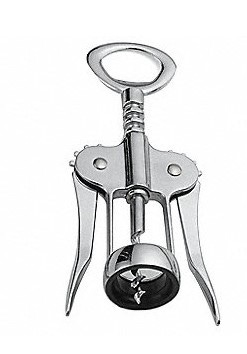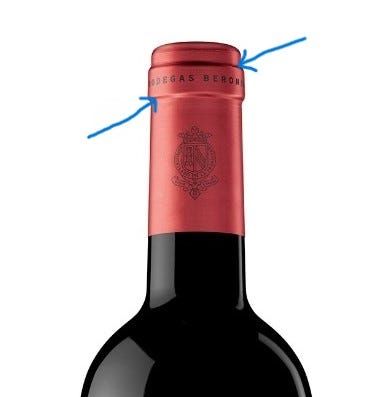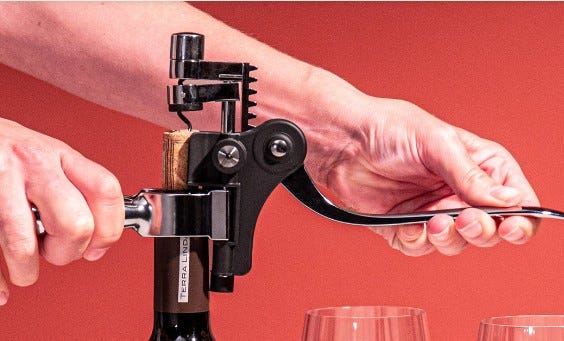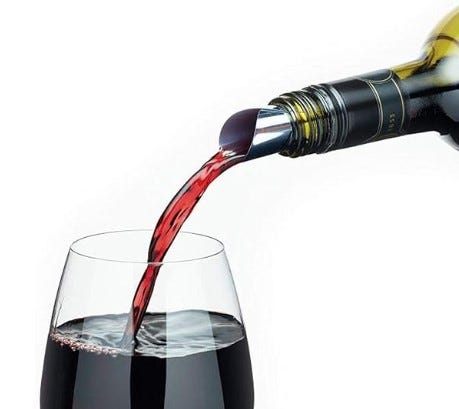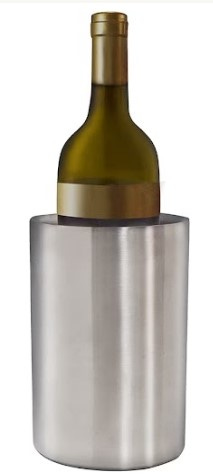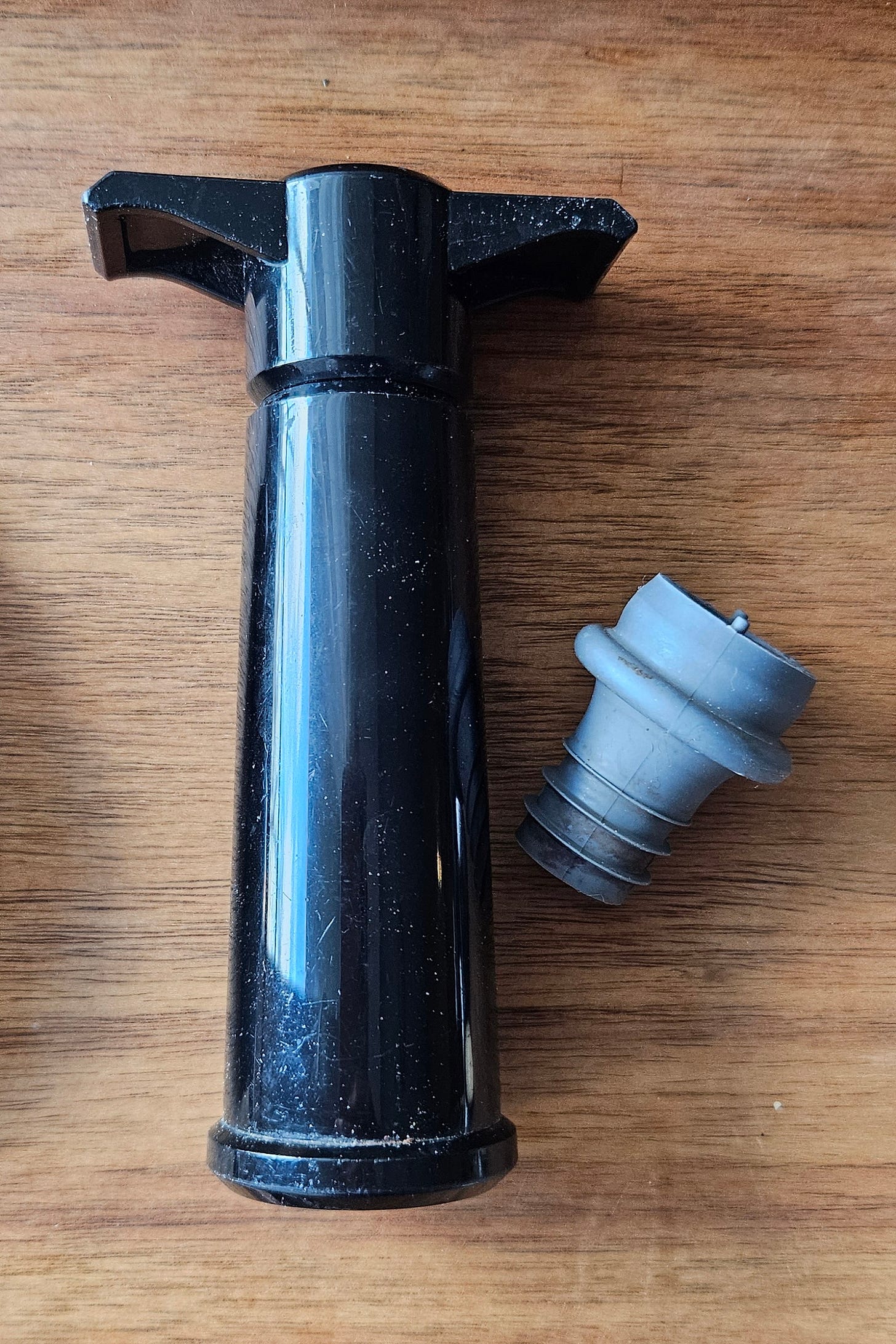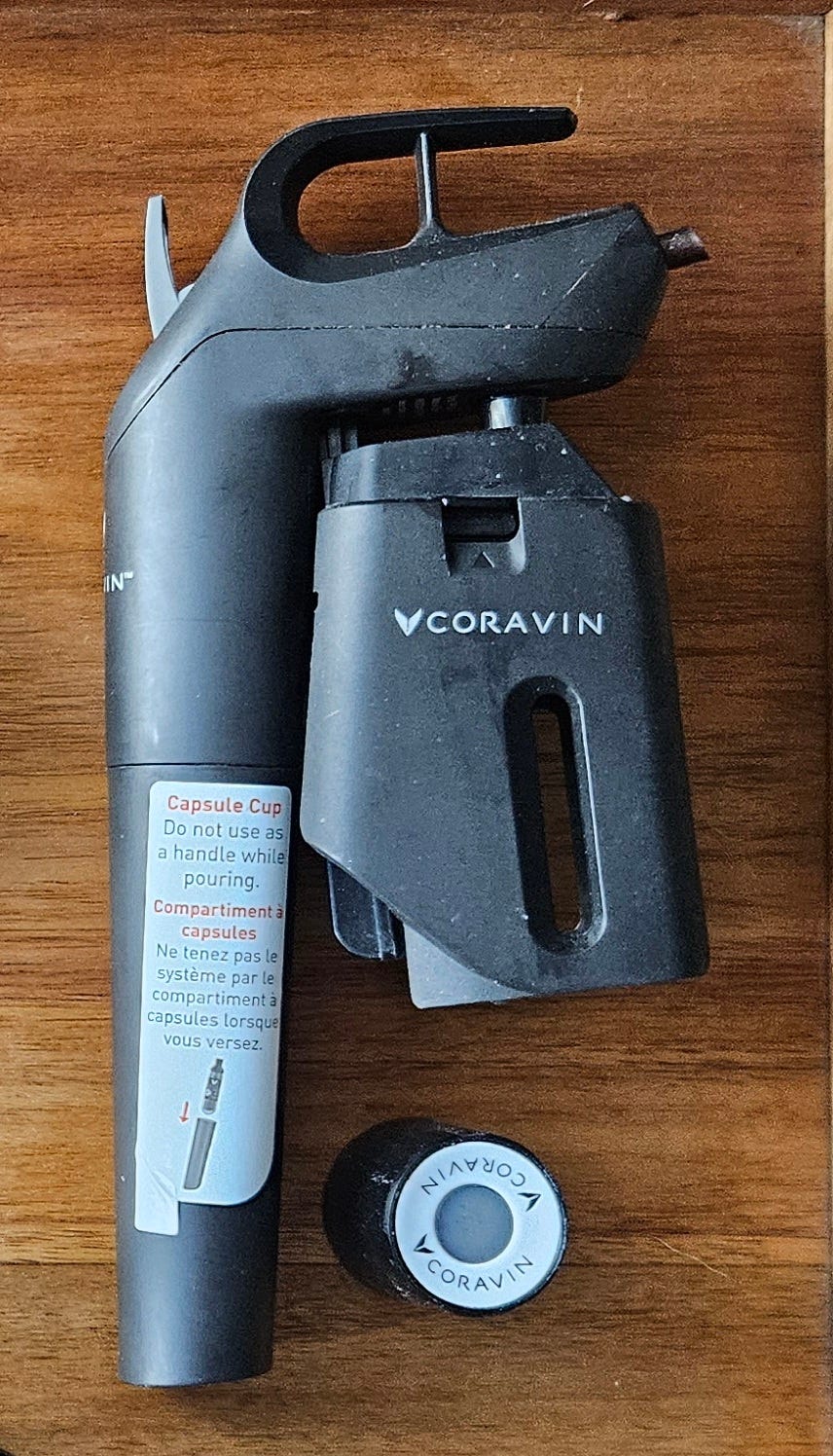Over the last 25-plus years that I’ve been learning about wine, I’ve bought my fair share of gadgets to help with the enjoyment of wine. I’ve mentioned some of them in past posts, but I thought it was worthwhile to put them all in one post.
Some are super useful, some are very expensive, and others mostly unnecessary. I’m putting them into three categories: opening wine, serving & pouring, and storing*. This image shows the gadgets I currently have, though I don’t still use them all. I’ll go over each one in detail and tell you what I like (and don’t like) about each of them.

Opening Wine
I think there are more gadgets sold for opening wine than any other. We all have our preferences in terms of which type of opener we prefer, and in some cases your choice might come down to dexterity or strength, so I’m not trying to shame anyone who doesn’t open wine the way a sommelier would. Use the opening device you feel most comfortable with. That said, there are still some best practices and tools you can use to make the process clean, safe, and efficient.
Foil cutter
Most bottles come with a metal or plastic wrap around the top of the bottle called the foil (even if it’s made of plastic) or capsule. The capsule protects the cork and the wine during storage, ageing, and shipping, but it has to be removed before opening the bottle. It’s not recommended to just push your corkscrew through the capsule because bits of metal can enter into the bottle or glass. There are a few ways to do this, but this gadget—the foil cutter—makes the job quick and easy.
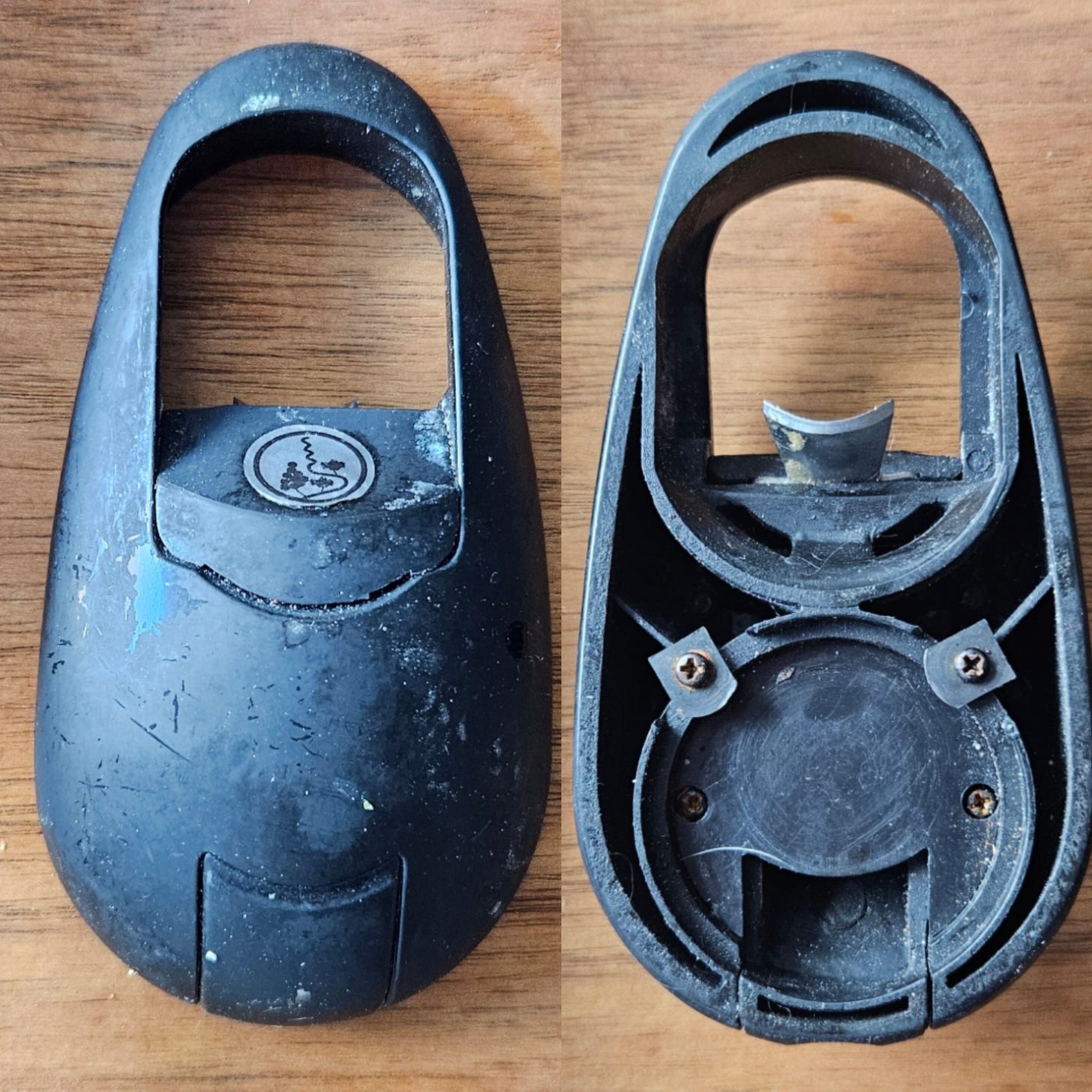
You put this on top of the bottle, press down on the button at the bottom, then turn it around the bottle. The cutters will score the perimeter of the foil or plastic capsule, then you can just remove it by hand. There are other, less bulky, types of foil cutters that also do the job.
Some bottles come with a plastic or wax disk on top of the cork, rather than a capsule. In this case, you can just use a knife to remove it, but if you have the gadget above, the little curved part at the top can be used to quickly remove the disk.
Winged corkscrew
We all grew up with this gadget and it’s quite simple to use. It’s also handy for people who might not have the strength to remove a cork and need a little help.
This corkscrew doesn’t really need any instructions, but I will reiterate that it’s still important to remove the capsule—with a foil cutter or a sharp knife—before you use this to open the bottle.
Waiter’s corkscrew
This is one of the most popular and least expensive types of wine openers. And it has a little knife attachment to remove the capsule, so you won’t need a separate gadget to do that.

There are two places on the bottle where the capsule can be removed:
The foil cutter mentioned above will slice the capsule at the upper lip (upper right arrow in the image above) but if you use the waiter’s corkscrew (or a regular knife) you can cut the capsule below the lower lip, which is preferred. There is no need to remove the entire capsule, but if it comes off (as some plastic capsules might) then that’s fine.
Insert the tip of the corkscrew into the centre of the cork (you’ll be holding the corkscrew at about a 45-degree angle to start, then straighten it out) then make about six half-turns until the corkscrew is well into the cork. This is where the two corkscrews pictured above will differ. The one on the left (which I love because it fits well in my hand, I love the wooden handle, and it was a gift from fellow red wine lady, Hilary) has one solid lever that you put on the upper lip of the bottle to help pull the cork out in one upward motion. The one on the right (which I got when I bought a few bottles of wine at Karlo Estates in Prince Edward County) is the standard waiter’s corkscrew with a hinged lever, allowing you to pull the cork in two separate steps. Use the first notch to pull the cork out half way, then use the second notch (after the lower hinge) to pull it out the rest of the way.
Rabbit Corkscrew
I used to have this device and found it much easier than the standard winged corkscrew. I don’t use it anymore because I prefer the waiter’s corkscrew and it takes up a lot of space.
You place the clamp around the neck of the bottle, then pull the lever forward to insert the corkscrew into the cork, then pull the lever back, extracting the cork. Easy peasy and great for people who might not have good grip strength.
Electric corkscrew
This is the ultimate in easy for people who have difficulty uncorking a bottle of wine. There are many different brands at different price points, so if you’re interested in buying one, I suggest you do a little research on which one might best suit your needs and budget. One point to note, you will still need to remove the capsule/foil before using an electric corkscrew, and many of them come with a device to do that.
Ah-so
This opener is for people who collect wine, especially old bottles where the cork might have deteriorated over time. If you’ve ever tried to open an older bottle and had the cork break or crumble on you, this is the device you should have used.
It takes some practice and you have to be really gentle with this, especially if the cork is old or damaged. What you do is insert the longer prong down one side of the cork (i.e., between the cork and the neck of the bottle,) then insert the shorter prong into the opposite side. Wiggle the prongs downward until they are all the way in, then gently turn the handle back and forth slightly as you pull the cork upward.
Serving Wine
This should be the easy part, right? And it generally is, but there are a few gadgets you can use that will make pouring and serving your wine nice and clean.
Wine spout
Some wine bottles will dribble, no matter how careful you are at pouring, so the wine spout is an inexpensive and handy gadget to use to prevent spills.
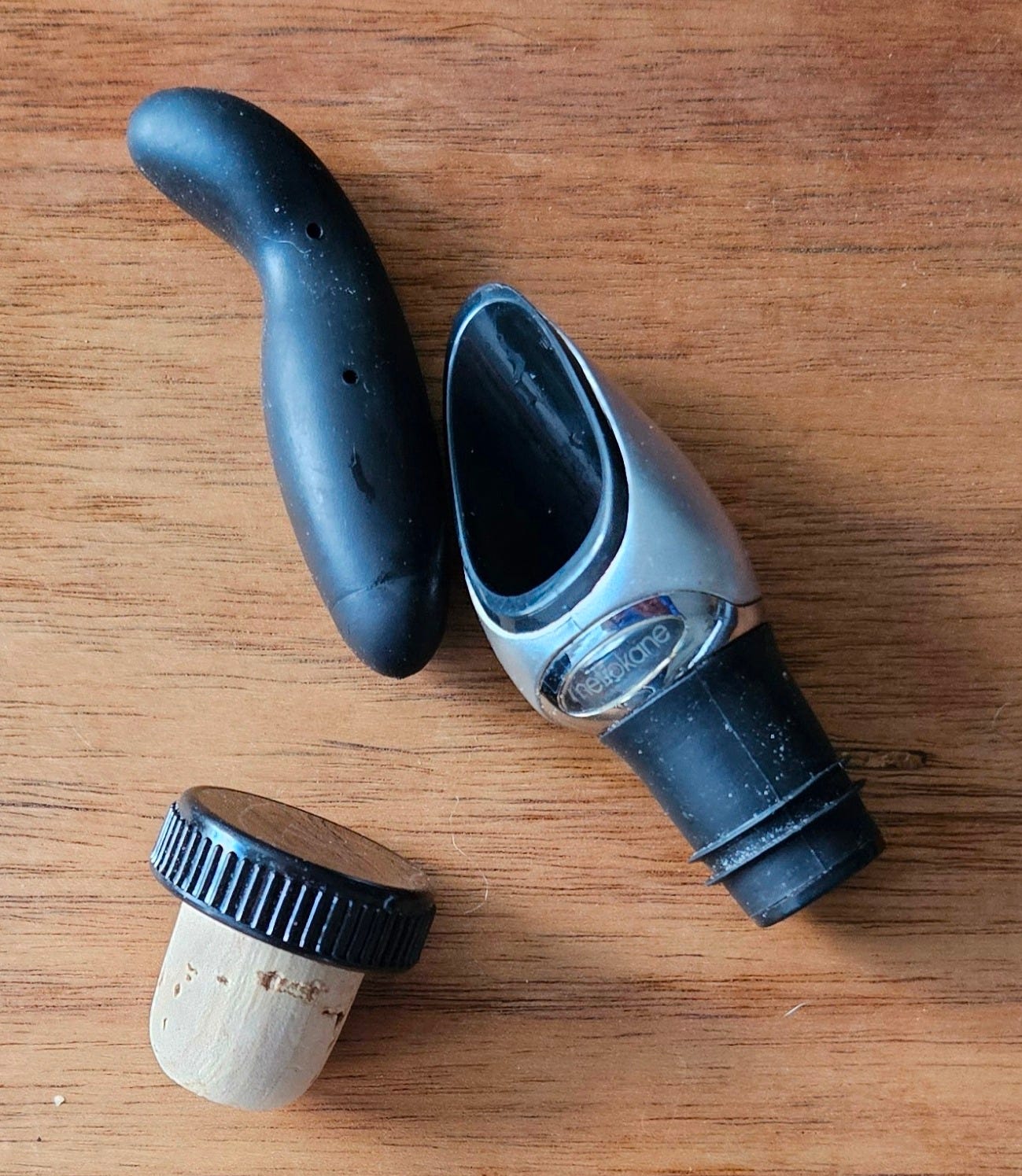
Pourers also slow down the stream of the wine so it doesn’t splash in your glass as you pour. This one can be a bit of a pain to clean, too. So, enter the wine pouring disk!
Wine pouring disc
Similar to the pourer above, the metal disk is gently folded into a tube, inserted in the bottle, and then the wine is poured.
The disk can be used multiple times (rinse between uses) and then discarded. They’re usually sold in packs of 10 and are quite inexpensive.
Decanter
Not all wines need to be decanted, but sometimes you don’t want to put the bottle on the table, so a decorative decanter is the solution. Decanting is usually done if you have an older bottle of wine that might need some time to open up before drinking. The simple act of pouring the wine out of the bottle into another container of any shape will usually aerate it sufficiently. But sometimes you want something a bit more decorative.
I’ve had a few different styles of decanter, but this is the one I currently use. It holds one full litre of liquid, so lots of room for aeration for one 750mL bottle of wine. You can also chill the concrete base to keep the wine cold. I wrote about this one a few months ago when I posted my holiday gift guide. The other popular style is the one that is wide and flat at the bottom. You can get one for about $25 at any kitchenware store.
Decanters can be a challenge to clean due to their shape and narrow openings. One tool I use frequently are cleaning beads. You can find these for about $20 and can be used over and over.
These are stainless steel beads that you put inside the decanter or carafe with a little bit of dish soap and water. You swirl them around to remove any debris or dried on wine from the bottom and sides of the decanter. When you’re done, pour them out into a strainer/sieve, rinse them in clear water, then put them back in their little case.
Cooler
Not to be confused with wine coolers that you drink (hello, summer of ‘85!) if you want to keep your wine cold and not have to run to the fridge every time you want to top up your glass, a wine cooler on the table might be what you’re looking for.
You can get them in metal, glass, or ceramic and they work quite well to keep an already-chilled bottle from warming up too quickly. As Cousin Jano and I mentioned on my most recent podcast (as well as the companion post,) it’s generally believed that most people drink their white wine too cold and their red wine too warm, so a device like this can help ensure your bottle is kept at just the right temperature.
Wine bucket
Even though I just said that we typically drink our white wines too cold, there is still a use for a wine bucket, though it should be used properly. Champagne—along with other sparkling wines—are typically served colder than you would serve still white wines. And cooling your champagne in a bucket of ice water is the fastest way to get it to the right temperature, especially if you forgot to put it in the fridge several hours before serving. And that part about ice water is key. Simply putting the bottle in or on ice won’t chill it as quickly or thoroughly than when it’s submerged up to the neck in ice cold water. So add some water to your bucket of ice, and refill with more ice as it melts (assuming you didn’t finish the bottle before then.) Keep a napkin or towel handy to wrap around the bottle so that you don’t drip water everywhere when you pour.
Storing Wine
Stoppers
Stoppers can be made of cork (as in the image above,) plastic, rubber, silicone, or glass. Some will provide better seals than others. The main purpose of a stopper is to temporarily seal the bottle if you don’t finish it in one sitting. As I’m sure you’ve tried, sometimes it’s hard to put the cork back into the bottle, even if you turn it upside down. That said, re-corking a bottle isn’t necessary for wine that will be consumed that same day/evening. It’s more so for preventing spillage. You can keep opened bottles of wine in the fridge for a few days (yes, even reds—just take the bottle out 30-40 minutes before you want to serve it) without worrying about it spoiling. And if you purchased wine with a screw top, you don’t even need to worry about putting a stopper in; the screw cap will work just fine.
Pump preserver
Air—and oxygen in particular—can be the enemy of wine over time. If you’ve ever poured another glass from a bottle that was left open too long, you know how that oxidative smell can ruin the wine. So, if you’re planning on holding your opened bottle of wine for more than a couple of days, a pump preserver might be a good option. This used to be my tool of choice as it’s inexpensive and effective.
You put the silicone stopper in the bottle, place the pump over top, then as you pull the plunger up several time it removes air from the bottle. When you want to open it, you just squeeze the sides of the stopper to release the vacuum seal, then remove the stopper. It won’t take all the air out, but does a fairly good job. And as mentioned with regular stoppers above, putting your opened bottle of wine in the fridge will help to extend it’s life a few more days.
Gas preservation
Not all air or gasses have a negative effect on wine, so using an argon gas spray to replace the oxygen in the bottle is another effective way of preserving your wine even longer than the pump or stopper. Argon gas doesn’t have any smell or taste, so it won’t affect the wine in any way and will prevent the wine from oxidation.
All-In-One Device
I’ve left the best (and most expensive) for last, because it can really fit into the opening, serving, and storing/preserving categories: the Coravin wine preservation system.
I’ve mentioned this device before and it has been invaluable to me over the last few years. As a single person, I don’t always want to have more than one glass in an evening, and I also don’t always want to (or am able to) drink a bottle over two or three consecutive days. The Coravin allows me to pour one glass from a bottle, then put that bottle away indefinitely. This is definitely a splurge as the model I have (Timeless) is about $300. This one will allow you to pour one glass of wine at a time from a bottle, then you can put the bottle away and come back to it months or years later, and it will be just as fresh. The hollow needle inside the device pierces the cork without removing it, allowing you to pour the wine, and then it replaces the air in the bottle with argon gas. This can only be used with natural corks that are in good condition. You have to buy extra argon capsules as you use them up, and I’ve also had to replace the needle a few times because it can bend or break over time. It can also be used with screw-top bottles: just remove the cap, replace it with the Coravin cap (provided) and pierce through that cap, which has a self-sealing silicone layer on top. They do have a less expensive model (Pivot) that will preserve your wine for 2-3 months (not years) and now have one made specifically for sparkling wines. There are also commercial-quality systems that allow restaurants to serve wines by the glass without worrying about maintaining freshness.
Summary
There is an endless array of wine-related gadgets available, some useful, some not. It really depends on what kind of wine drinker you are and how much you want to spend on your hobby. Hopefully, this summary of some of the most popular accessories will help you decide which ones are right for you.
*I realize that for some people the thought of storing “leftover wine” is a foreign concept, so I will leave you with this funny little vignette from my sister Carolyn’s former show. [I think this video might only be available in Canada, though.]




